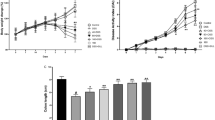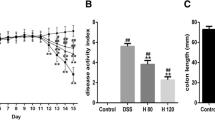Abstract
The protective potential of dandelion on acute hepatitis, lung injury and colorectal cancer has recently been revealed. Importantly, ulcerative colitis (UC), a clinically defined inflammatory bowel disease, accelerates the risk of colorectal cancer. However, studies focusing on the activity of dandelion on UC are extremely limited. In the present study, we found that an aqueous extract of dandelion root increases cell viability and decreases apoptosis in dextran sodium sulfate (DSS)-incubated NCM460 human colonic epithelial cells, probably through removing the production of reaction oxygen species and blocking nuclear factor-kappaB signaling. We then examined the anti-colitis efficacy of this extract in an in vivo study. We detected that dandelion root extract efficiently ameliorates progressive acute injury as demonstrated by a reduction in body weight loss, severity scores of disease index and shortened colon length during DSS treatment, as well as reducing the inflammatory conditions and oxidative stress in the colon of DSS-induced mice. Our study clearly demonstrates that dandelion has a strong cytoprotective effect on NCM460 colonocytes and shows powerful defense on an established experimental mouse model of DSS-induced UC. Therefore, dandelion root extract can be an effective anti-colitis complex mixture and can provide a complementary alternative to currently available therapeutic intervention in UC.






Similar content being viewed by others

References
Marchi P, Paiotti APR, Neto RA, Oshima CTF, Ribeiro DA (2014) Concentrated grape juice (G8000™) reduces immunoexpression of iNOS, TNF-alpha, COX-2 and DNA damage on 2, 4, 6-trinitrobenzene sulfonic acid-induced-colitis. Environ Toxicol Pharmacol 37:819–827
Liu TC, Stappenbeck TS (2016) Genetics and pathogenesis of inflammatory bowel disease. Annu Rev Pathol 11:127–148
Lu MC, Ji JA, Jiang YL, Chen ZY, Yuan ZW, You QD, Jiang ZY (2016) An inhibitor of the Keap1–Nrf2 protein–protein interaction protects NCM460 colonic cells and alleviates experimental colitis. Sci Rep 6:26585
Artis D (2008) Epithelial-cell recognition of commensal bacteria and maintenance of immune homeostasis in the gut. Nat Rev Immunol 8:411–420
Rosenberg LN, Peppercorn MA (2010) Efficacy and safety of drugs for ulcerative colitis. Expert Opin Drug Saf 9:573–592
Abu-Rabia A (2015) Key plants in fighting cancer in the Middle East. Chin Med 6:124
Sigstedt SC, Hooten CJ, Callewaert MC, Jenkins AR, Romero AE, Pullin MJ, Kornienko A, Lowrey TK, Slambrouck SV, Steelant WF (2008) Evaluation of aqueous extracts of Taraxacum officinale on growth and invasion of breast and prostate cancer cells. Int J Oncol 32:1085–1090
Ovadje P, Chatterjee S, Griffin C, Tran C, Hamm C, Pandey S (2011) Selective induction of apoptosis through activation of caspase-8 in human leukemia cells (Jurkat) by dandelion root extract. J Ethnopharmacol 133:86–91
Ovadje P, Chochkeh M, Akbari-Asl P, Hamm C, Pandey S (2012) Selective induction of apoptosis and autophagy through treatment with dandelion root extract in human pancreatic cancer cells. Pancreas 41:1039–1047
Ovadje P, Ammar S, Guerrero JA, Arnason JT, Pandey S (2016) Dandelion root extract affects colorectal cancer proliferation and survival through the activation of multiple death signalling pathways. Oncotarget 7:73080–73100
Yarnell E, Abascal K (2009) Dandelion (Taraxacum officinale and T. mongolicum). Integr Med 8:35–38
Martinez M, Poirrier P, Chamy R, Prüfer D, Schulze-Gronover C, Jorquera L, Ruiz G (2015) Taraxacum officinale and related species−an ethnopharmacological review and its potential as a commercial medicinal plant. J Ethnopharmacol 169:244–262
Ma C, Zhu L, Wang J, He H, Chang X, Gao J, Shumin W, Yan T (2015) Anti-inflammatory effects of water extract of Taraxacum mongolicum hand.-Mazz on lipopolysaccharide-induced inflammation in acute lung injury by suppressing PI3K/Akt/mTOR signaling pathway. J Ethnopharmacol 168:349–355
You Y, Yoo S, Yoon HG, Park J, Lee YH, Kim S, Oh KT, Lee J, Cho HY, Jun W (2010) In vitro and in vivo hepatoprotective effects of the aqueous extract from Taraxacum officinale (dandelion) root against alcohol-induced oxidative stress. Food Chem Toxicol 48:1632–1637
Tang C, Kamiya T, Liu Y, Kadoki M, Kakuta S, Oshima K, Hattori M, Takeshita K, Kanai T, Saijo S, Ohno N, Iwakura Y (2015) Inhibition of dectin-1 signaling ameliorates colitis by inducing Lactobacillus-mediated regulatory T cell expansion in the intestine. Cell Host Microbe 18:183–197
Chen XH, Zhang BW, Li H, Peng XX (2015) Myo-inositol improves the host’s ability to eliminate balofloxacin-resistant Escherichia coli. Sci Rep 5:10720
Chen XH, Liu SR, Peng B, Li D, Cheng ZX, Zhu JX, Zhang S, Peng YM, Li H, Zhang TT, Peng XX (2017) Exogenous l-valine promotes phagocytosis to kill multidrug-resistant bacterial pathogens. Front Immunol 8:207
Dai M, Wang F, Zou Z, Xiao G, Chen H, Yang H (2017) Metabolic regulations of a decoction of Hedyotis diffusa in acute liver injury of mouse models. Chin Med 12:35
Danial NN, Korsmeyer SJ (2004) Cell death: critical control points. Cell 116:205–219
Bhattacharyya S, Dudeja PK, Tobacman JK (2008) ROS, Hsp27, and IKKβ mediate dextran sodium sulfate (DSS) activation of IκBa, NFκB, and IL-8. Inflamm Bowel Dis 15:673–683
Francescone R, Hou V, Grivennikov SI (2015) Cytokines, IBD and colitis-associated cancer. Inflamm Bowel Dis 21:409–418
Zhong H, May MJ, Jimi E, Ghosh S (2002) The phosphorylation status of nuclear NF-κB determines its association with CBP/p300 or HDAC-1. Mol Cell 9:625–636
Shenkar R, Abraham E (1999) Mechanisms of lung neutrophil activation after hemorrhage or endotoxemia: roles of reactive oxygen intermediates, NF-κB, and cyclic AMP response element binding protein. J Immunol 163:954–962
Kubinak JL, Petersen C, Stephens WZ, Soto R, Bake E, O’Connell RM, Round JL (2015) MyD88 signaling in T cells directs IgA-mediated control of the microbiota to promote health. Cell Host Microbe 17:153–163
Yum H-W, Zhong X, Park J, Na HK, Kim N, Lee HS, Surh YJ (2013) Oligonol inhibits dextran sulfate sodium-induced colitis and colonic adenoma formation in mice. Antioxid Redox Signal 19:102–114
Jena G, Trivedi PP, Sandala B (2012) Oxidative stress in ulcerative colitis: an old concept but a new concern. Free Radic Res 46:1339–1345
Chang TS, Jeong W, Woo HA, Lee SM, Park S, Rhee SG (2004) Characterization of mammalian sulfiredoxin and its reactivation of hyperoxidized peroxiredoxin through reduction of cysteine sulfinic acid in the active site to cysteine. J Biol Chem 279:50994–51001
Kopriva S (2006) Regulation of sulfate assimilation in Arabidopsis and beyond. Ann Bot 97:479–495
Aleksunes LM, Manautou JE (2007) Emerging role of Nrf2 in protecting against hepatic and gastrointestinal disease. Toxicol Pathol 35:459–473
Hayyan M, Hashim MA, AlNashef IM (2016) Superoxide ion: generation and chemical implications. Chem Rev 116:3029–3085
Kenmogne-Domguia HB, Moisan S, Viau M, Genot C, Meynier A (2014) The initial characteristics of marine oil emulsions and the composition of the media inflect lipid oxidation during in vitro gastrointestinal digestion. Food Chem 152:146–154
Risk L (2011) Vitamin E and the risk of prostate cancer: the Selenium and Vitamin E Cancer Prevention Trial (SELECT). JAMA 306:1549–1556
Le Gal K, Ibrahim MX, Wiel C, Sayin VI, Akula MK, Karlsson C, Dalin MG, Akyürek LM, Lindahl P, Nilsson J, Bergo MO (2015) Antioxidants can increase melanoma metastasis in mice. Sci Transl Med 7:308re8
Sayin VI, Ibrahim MX, Larsson E, Nilsson JA, Lindahl P, Bergo MO (2014) Antioxidants accelerate lung cancer progression in mice. Sci Transl Med 6:221ra15
Ginn-Pease ME, Whisler RL (1998) Redox signals and NF-κB activation in T cells. Free Radic Biol Med 25:346–361
Hegazy SK, El-Bedewy MM (2010) Effect of probiotics on pro-inflammatory cytokines and NF-κB activation in ulcerative colitis. World J Gastroenterol 16:4145–4151
Shin HS, Satsu H, Bae MJ, Zhao Z, Ogiwara H, Totsuka M, Shimizu M (2015) Anti-inflammatory effect of chlorogenic acid on the IL-8 production in Caco-2 cells and the dextran sulphate sodium-induced colitis symptoms in C57BL/6 mice. Food Chem 168:167–175
Dae Park D, Yum H-W, Zhong X, Kim SH, Kim SH, Kim DH, Kim SJ, Na HK, Sato A, Miura T, Surh YJ (2017) Perilla frutescens extracts protects against dextran sulfate sodium-induced murine colitis: NF-κB, STAT3, and Nrf2 as putative targets. Front Pharmacol 8:482
Kryczek I, Wang L, Wu K, Li W, Zhao E, Cui T, Wei S, Liu Y, Wang Y, Vatan L, Szeliga W, Greenson JK, Roliński J, Zgodzinski W, Huang E, Tao K, Wang G, Zou W (2016) Inflammatory regulatory T cells in the microenvironments of ulcerative colitis and colon carcinoma. Oncoimmunology 5:e1105430
González-Castejón M, Visioli F, Rodriguez-Casado A (2012) Diverse biological activities of dandelion. Nutr Rev 70:534–547
Zhang X, Xiong H, Li H, Cheng Y (2014) Protective effect of taraxasterol against LPS-induced endotoxic shock by modulating inflammatory responses in mice. Immunopharmacol Immunotoxicol 36:11–16
San Z, Fu Y, Li W, Zhou E, Li Y, Song X, Wang T, Tian Y, Wei Z, Yao M, Cao Y, Zhang N (2014) Protective effect of taraxasterol on acute lung injury induced by lipopolysaccharide in mice. Int Immunopharmacol 19:342–350
Park CM, Park JY, Song YS (2010) Luteolin and chicoric acid, two major constituents of dandelion leaf, inhibit nitric oxide and lipid peroxide formation in lipopolysaccharide-stimulated RAW 264.7 cells. Int J Food Sci Nutr 15:92–97
Park CM, Youn HJ, Chang HK, Song YS (2010) TOP1 and 2, polysaccharides from Taraxacum officinale, attenuate CCl4-induced hepatic damage through the modulation of NF-κB and its regulatory mediators. Food Chem Toxicol 48:1255–1261
Author information
Authors and Affiliations
Contributions
AGD designed the experiments. AGD performed the experiments. XHW analyzed the data. XHW wrote the paper. All the authors read and approved the final manuscript.
Corresponding author
Rights and permissions
About this article
Cite this article
Ding, A., Wen, X. Dandelion root extract protects NCM460 colonic cells and relieves experimental mouse colitis. J Nat Med 72, 857–866 (2018). https://doi.org/10.1007/s11418-018-1217-7
Received:
Accepted:
Published:
Issue Date:
DOI: https://doi.org/10.1007/s11418-018-1217-7



